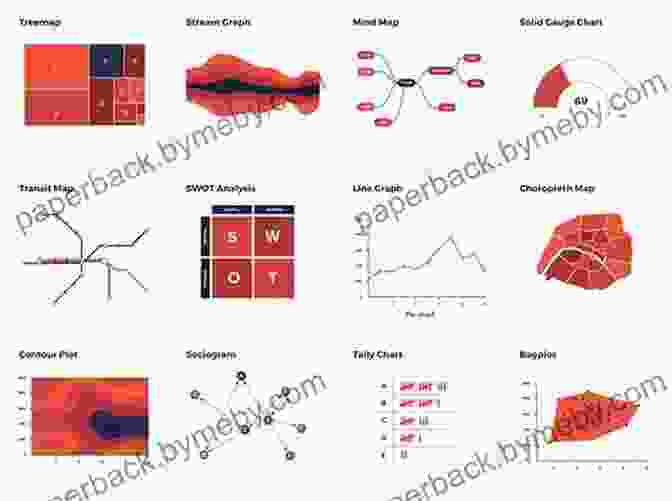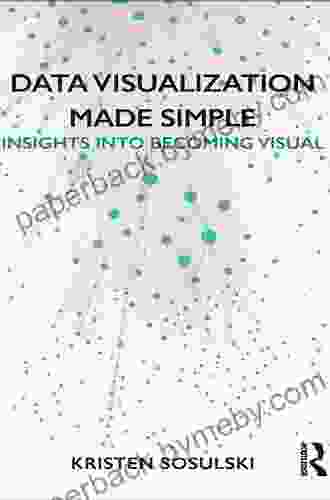Data Visualization Made Simple: Insights Into Becoming Visual

4.3 out of 5
| Language | : | English |
| File size | : | 61274 KB |
| Screen Reader | : | Supported |
| Print length | : | 284 pages |
Understanding Data Visualization
In today's data-driven world, the ability to effectively visualize data has become a critical skill. Data visualization involves representing data in graphical formats, such as charts, graphs, and maps, to make it easier to understand and communicate. By presenting data visually, we can identify trends, patterns, and insights that might otherwise be hidden within the raw data.

There are numerous types of data visualizations, each suited to specific types of data and objectives. Some common types include:
- Bar charts: Used to compare values across different categories.
- Line charts: Used to show trends over time.
- Pie charts: Used to show proportions within a whole.
- Scatterplots: Used to explore relationships between two variables.
- Maps: Used to visualize spatial data.
Principles of Effective Data Visualization
Creating effective data visualizations requires adherence to certain design principles. These principles ensure that the visualizations are both visually appealing and informative.
- Simplicity: Keep visualizations simple and uncluttered to avoid overwhelming the audience.
- Focus: Highlight the most important insights and draw the viewer's attention to them.
- Accuracy: Ensure that the visualizations accurately represent the underlying data.
- Clarity: Use clear and concise labels, legends, and titles to facilitate understanding.
- Consistency: Maintain consistency in the use of colors, fonts, and styles throughout the visualizations.
Data Storytelling with Visualizations
Effective data visualizations go beyond simply presenting data; they tell a story. By carefully crafting visualizations and arranging them in a logical sequence, we can guide the audience through the data, uncover insights, and lead them to desired s.
Consider the following steps when using data visualizations to tell a story:
- Identify the key message or insight you want to convey.
- Choose the most appropriate visualization type to support your message.
- Design the visualization according to the principles of effectiveness.
- Arrange the visualizations in a logical sequence to guide the viewer through the story.
- Use annotations, labels, and titles to provide context and clarify the insights.
Benefits of Data Visualization
Incorporating data visualization into your data analysis and communication processes offers numerous benefits:
- Improved Data Understanding: Visualizations make data more accessible and understandable.
- Enhanced Decision-Making: Data visualizations provide decision-makers with clear and actionable insights.
- Increased Efficiency: Visualizations summarize complex data, saving time and effort.
- Audience Engagement: Visualizations are visually appealing and capture attention.
- Effective Communication: Visualizations facilitate effective communication of insights to both technical and non-technical audiences.
Data visualization is an essential skill in today's data-driven world. By mastering the principles of data visualization and incorporating them into your data analysis and communication processes, you can unlock the power of data and transform it into compelling insights. Embrace the visual revolution and become a data visualization expert to effectively present and communicate your findings, making data analysis a breeze and empowering data-driven decision-making.
Embrace the power of data visualization with "Data Visualization Made Simple: Insights Into Becoming Visual." This comprehensive guide delves into the intricacies of data visualization, providing valuable insights and practical techniques to help you unlock the potential of data and make informed decisions.
4.3 out of 5
| Language | : | English |
| File size | : | 61274 KB |
| Screen Reader | : | Supported |
| Print length | : | 284 pages |
Do you want to contribute by writing guest posts on this blog?
Please contact us and send us a resume of previous articles that you have written.
 Book
Book Novel
Novel Page
Page Chapter
Chapter Text
Text Story
Story Genre
Genre Reader
Reader Library
Library Paperback
Paperback E-book
E-book Magazine
Magazine Newspaper
Newspaper Paragraph
Paragraph Sentence
Sentence Bookmark
Bookmark Shelf
Shelf Glossary
Glossary Bibliography
Bibliography Foreword
Foreword Preface
Preface Synopsis
Synopsis Annotation
Annotation Footnote
Footnote Manuscript
Manuscript Scroll
Scroll Codex
Codex Tome
Tome Bestseller
Bestseller Classics
Classics Library card
Library card Narrative
Narrative Biography
Biography Autobiography
Autobiography Memoir
Memoir Reference
Reference Encyclopedia
Encyclopedia Kenneth T Walsh
Kenneth T Walsh Kim Todd
Kim Todd Sally Spencer
Sally Spencer Leonardo Urdaneta
Leonardo Urdaneta Nicholas Marsh
Nicholas Marsh Robert J Sweet
Robert J Sweet Ross W Greene
Ross W Greene Kenneth Laws
Kenneth Laws Stan Weinstein
Stan Weinstein Ryan S Walters
Ryan S Walters Ken Seeroi
Ken Seeroi Marc Ecko
Marc Ecko Norman Lewis
Norman Lewis Ron Miner
Ron Miner Melissa Haynes
Melissa Haynes Peyman Vahabzadeh
Peyman Vahabzadeh Susan Srikant
Susan Srikant Wolfram Siemann
Wolfram Siemann Oscar Baechler
Oscar Baechler Kevin Henry
Kevin Henry
Light bulbAdvertise smarter! Our strategic ad space ensures maximum exposure. Reserve your spot today!

 Kelly BlairTobacco Cigarettes and Batik Design: An Intricate Dance of History, Culture,...
Kelly BlairTobacco Cigarettes and Batik Design: An Intricate Dance of History, Culture,...
 Sean TurnerSpanish Phrases For Beginners Cartoon Vocabulary: Unlock Your Spanish Fluency...
Sean TurnerSpanish Phrases For Beginners Cartoon Vocabulary: Unlock Your Spanish Fluency... Anthony WellsFollow ·6.2k
Anthony WellsFollow ·6.2k Jeffery BellFollow ·13.3k
Jeffery BellFollow ·13.3k Ethan MitchellFollow ·19k
Ethan MitchellFollow ·19k Jorge Luis BorgesFollow ·18.1k
Jorge Luis BorgesFollow ·18.1k Terry BellFollow ·16.7k
Terry BellFollow ·16.7k Hugh ReedFollow ·19.6k
Hugh ReedFollow ·19.6k Derek CookFollow ·3.5k
Derek CookFollow ·3.5k Howard BlairFollow ·12.5k
Howard BlairFollow ·12.5k

 Isaac Asimov
Isaac AsimovEmbark on an Epic Adventure: The Colorado Trail 9th...
Unveiling the Treasures of the Colorado...

 Clinton Reed
Clinton ReedUltimate Football Heroes: Uncover the Gridiron Greatness...
Enter the World...

 Ibrahim Blair
Ibrahim BlairUnveiling the Secrets of Stolen Focus: A Journey to...
In today's relentless digital...

 Colt Simmons
Colt SimmonsRediscover the Founding Father's Vision: Thomas Jefferson...
Immerse Yourself in the Unedited Words of...

 Juan Butler
Juan ButlerExcel in Language Learning: The Ultimate Self-Study...
Unlock Your Language Potential with Our...
4.3 out of 5
| Language | : | English |
| File size | : | 61274 KB |
| Screen Reader | : | Supported |
| Print length | : | 284 pages |










